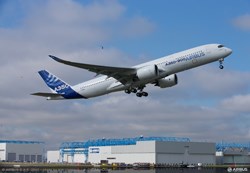With the A350 XWB in the air, is it too soon to start looking to the future?
What will be the role of composites in replacements for the A320 and 737?

Now that the Airbus A350 XWB is in the air and beginning flight testing, and given the fact that its delivery is, for all intents and purposes, imminent, is it too soon for the composites community to start thinking more seriously about composites use in the next generation of planes to come out of Airbus and Boeing?
In some ways, this is a rhetorical question, because we know Airbus and Boeing and their suppliers have been giving this idea much thought for several years already. It's probaby only fair that the rest of us be allowed to enter the conversation now that the 787 and A350 XWB have become reality.
There are, as near as we can tell, three basic questions facing the designers of the next generation of commercial aircraft — specifically, replacements for the A320 and 737:
1. If, where and how much will composites be used in the fuselage of a narrow-body plane like the A320 and 737? Production volumes and fuselage skin thickness might favor aluminum, but composites material and machinery suppliers are working quickly to try and change the equation.
2. If, where and how much will out-of-autoclave (OOA) resins be used? If current production rates prevail, Boeing and Airbus will want to make at least one plane a day of the A320 and 737 replacements. The autoclave is not conducive to such volumes, which makes OOA resins very attractive.
3. If, where and how much will thermoplastics be used? There is much R&D being done to prove the viability of thermoplastics in commercial aerostructures. If the progress of the last five years is any indicator, then thermoplastics might be sufficiently evolved soon to make it a viable aerospace material.
Let us know your thoughts, and let us know if there's a question we've overlooked.
Related Content
-
Industrializing additive manufacturing in the defense/aerospace sector
GA-ASI demonstrates a path forward for the use of additive technologies for composite tooling, flight-qualified parts.
-
Low-cost, efficient CFRP anisogrid lattice structures
CIRA uses patented parallel winding, dry fiber, silicone tooling and resin infusion to cut labor for lightweight, heavily loaded space applications.
-
Combining multifunctional thermoplastic composites, additive manufacturing for next-gen airframe structures
The DOMMINIO project combines AFP with 3D printed gyroid cores, embedded SHM sensors and smart materials for induction-driven disassembly of parts at end of life.






